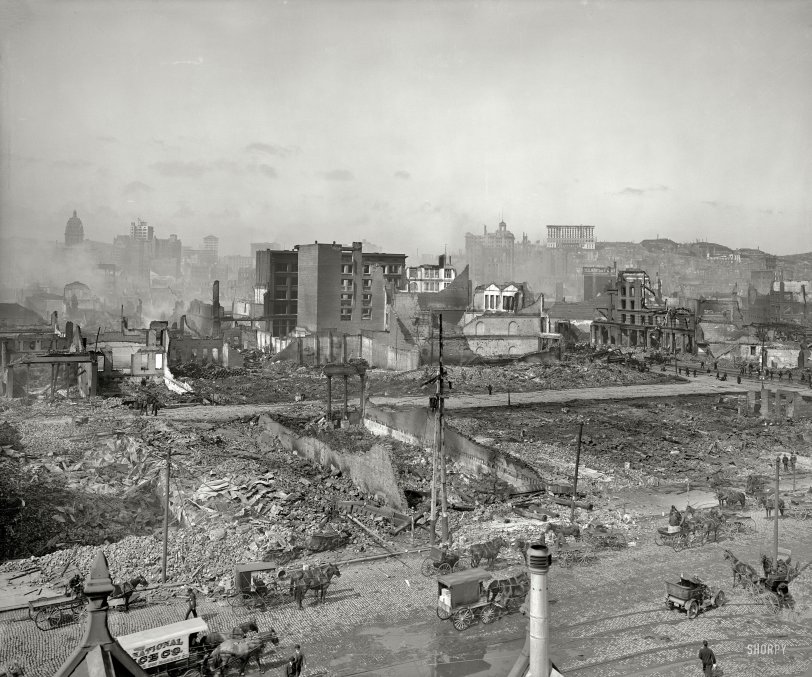


Framed or unframed, desk size to sofa size, printed by us in Arizona and Alabama since 2007. Explore now.
Shorpy is funded by you. Patreon contributors get an ad-free experience.
Learn more.

- Roll your own
- Rugged and real!
- A Charles Purcell - Mama Cass Connection
- Uncle SAAM
- Obfuscation
- One Chocolate Soldier rode away
- Victor Marquis de la Roche
- The Little House Across Way ...
- Vanderbilt Gates
- Vanderbilt Mansion
- You can still see that gate
- Withering heights for me
- So Jim,
- Top Heavy
- Re: Can't Place It.
- Bus ID
- Since you mention it
- The White Pages ?
- Moonlight Tower
- 1907?
- Fire(men) and Water
- Can't Place It
- Can anyone
- Wings
- Where's Claudette and Clark?
- Overbuilt Rolodex
- One song
- Give Me Wings Please!
- PRR
- Pinball Wizards
Printporium
Smoking Rubble: 1906

"Nob Hill from roof of Ferry Post Office." San Francisco after the earthquake and fire of April 18, 1906. Detroit Publishing glass negative. View full size.
London on Frisco
Jack London on the quake:
Day was trying to dawn through the smoke-pall. A sickly light was creeping over the face of things. Once only the sun broke through the smoke-pall, blood-red, and showing quarter its usual size. The smoke-pall itself, viewed from beneath, was a rose color that pulsed and fluttered with lavender shades Then it turned to mauve and yellow and dun. There was no sun. And so dawned the second day on stricken San Francisco.
Granddad
My grandfather (who died a year before I was born) claimed he was there for the earthquake, he was quite the wanderer in his early years. I wonder if he saw Caruso?
San Francisco
San Francisco is such a fascinating city to me because as I rode the cable cars up and down its steep hilly streets, I wondered, "Who in the world thought this was a good place to build a city?"
I simply couldn't imagine being one of the first to enter this land and thinking it was a good idea to build a house and neighborhood on a street with a 60 degree incline. Surely they could have gone out just a bit farther and found flatter land.
Add to it this earthquake, and I marvel that they didn't just throw up their hands and find flatter land to settle in.
Glad they didn't though; SF is a gem among gems.
[Like most coastal cities, SF is where it is because of maritime geography, not topography -- an anchorage at the mouth of a sheltered bay. - Dave]
Rubble rubble everywhere
Vast quantities of rubble were dumped along San Francisco's bay shore from Fisherman's Wharf to south of today's AT&T baseball park. The motive power? Mules, horses, and trains that ran on tracks laid temporarily atop city streets especially for the purpose. (According to the Library of Congress, nearly 17,000 horses were worked to death in the process. No stats for the poor mules.)
Historians agree, though, that little if any earthquake rubble was dumped in the modern Marina District. The reason? The undeveloped area (then called Harbor View) was too far from the destroyed downtown areas being cleared to be useful. Also, the intervening hills between downtown and Harbor View prohibiting laying railroad track.
Shaky Foundations
I have read that the Marina District which was heavily damaged in the last quake was built on fill from this quake. Kind of ironic when you think about it.
Re: Too Much
It is a good thing everyone did not feel such despair. They got up, dusted themselves off and went to work to rebuild the city.
Whittell Building
About one quarter away from the left in the distance is the skeleton of a building with a low-peaked roof. It's not an earthquake victim, but the Whittell Building, under construction at the time. Local architects actually designed it to be seismically resistant; construction was completed and it stands to this day on Union Square. My Uncle Frank had his lapidary business in it from the 1920s until he retired. I remember riding up to it in the rickety cage elevator, and the gnarled old guy who operated it.
Highlander
The Fairmont is still there. You can't see it from this distance but all of the windows broke from the heat. When the quake struck the hotel was still two weeks from opening; the furnishings had been delivered but not yet arranged, perhaps sparing the place from the fiery, utter destruction that the neighboring hotels met with.
She finally opened a year to the day after the quake.
Caruso's Last Stand
And after being awakened by the tremor, Caruso vowed never to return to San Francisco, a vow which he kept. As for the Fairmont Hotel, it was nearly complete at the time of the earthquake and fire, and its opening was delayed until the next year.
At the far left is another landmark of the time, the Call-Spreckels Building, home of the San Francisco Call newspaper.
Hotel Fairmont
Looks like the hotel off in the distance. The outside of the building survived relatively unscathed, but the interior suffered fire damage.
This is one of the most interesting images of the aftermath I've seen. I get a real sense of what it must have been like to see and be amongst the destruction. So much to clean up before the rebuilding begins.
Too much
Where and how do you even begin to clean up the debris? It's all just so overwhelming.
Awful Damage
With every one of these I see on Shorpy, all I can think of is Hiroshima or Berlin circa 1945. Did you know that Enrico Caruso was in town at the time?
























On Shorpy:
Today’s Top 5